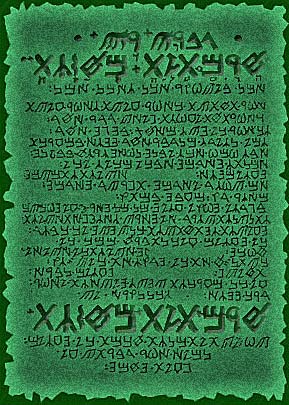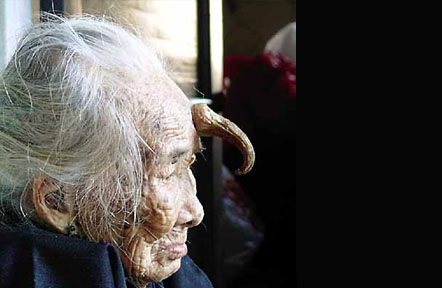In 1911 several giant skeletons and ancient artefacts were supposedly fund in a cave in Lovelock in Nevada, USA. Almost everything was later lost in a fire but a skull is supposed to be found in the Humbolt Museum, Winnemucca. Many Native American tribes from the Northeast and Southwest still relate the legends of the red-haired giants and how their ancestors fought terrible, protracted wars against the giants when they first encountered them in North America almost 15,000 years ago.
When mining for guano in a cave in Lovelock, a small town about 80 miles north-east of Reno, the miners reportedly found mummies preserved in the dry bat-droppings. The mummies were large, from 6 and a half feet to more that 8 feet (2 to more than 2,5 meters), and they had red hair. They were reportedly lying in a layer of burnt material about four feet under the surface and there were also lots of broken arrows around the mummies. Before archaeologists could survey the findings most of it was gone or damaged - and a later fire where the artefacts were stored did no good either.
Legends
The Puite Indians of the area have legends about giants and how they killed them. The race of giants, the "Si-Te-Cah" , should have been white, red-haired, very tall cannibals, and the Indians started war against them when they entered their land. A coalition of tribes managed to trap the last remaining giants in a cave and while shooting arrows at them they started a large fire at the mouth of the cave. They kept the fire going and shot everybody who tried to get out - until the giants were annihilated. The Paiutes, a Native-American tribe indigenous to parts of Nevada, Utah and Arizona, told early white settlers about their ancestors’ battles with a ferocious race of white, red-haired giants. According to the Paiutes, the giants were already living in the area.
The Paiutes named the giants “Si-Te-Cah” that literally means “tule-eaters.” The tule is a fibrous water plant the giants wove into rafts to escape the Paiutes continuous attacks. They used the rafts to navigate across what remained of Lake Lahontan.
According to the Paiutes, the red-haired giants stood as tall as 12-feet and were a vicious, unapproachable people that killed and ate captured Paiutes as food.
The Paiutes told the early settlers that after many years of warfare, all the tribes in the area finally joined together to rid themselves of the giants.
One day as they chased down the few remaining red-haired enemy, the fleeing giants took refuge in a cave. The tribal warriors demanded their enemy come out and fight, but the giants steadfastly refused to leave their sanctuary.
Lovelock giant skull - Who Were The Si-Te-Cah
When mining for guano in a cave in Lovelock, a small town about 80 miles north-east of Reno, the miners reportedly found mummies preserved in the dry bat-droppings. The mummies were large, from 6 and a half feet to more that 8 feet (2 to more than 2,5 meters), and they had red hair. They were reportedly lying in a layer of burnt material about four feet under the surface and there were also lots of broken arrows around the mummies. Before archaeologists could survey the findings most of it was gone or damaged - and a later fire where the artefacts were stored did no good either.
Legends
The Puite Indians of the area have legends about giants and how they killed them. The race of giants, the "Si-Te-Cah" , should have been white, red-haired, very tall cannibals, and the Indians started war against them when they entered their land. A coalition of tribes managed to trap the last remaining giants in a cave and while shooting arrows at them they started a large fire at the mouth of the cave. They kept the fire going and shot everybody who tried to get out - until the giants were annihilated. The Paiutes, a Native-American tribe indigenous to parts of Nevada, Utah and Arizona, told early white settlers about their ancestors’ battles with a ferocious race of white, red-haired giants. According to the Paiutes, the giants were already living in the area.
The Paiutes named the giants “Si-Te-Cah” that literally means “tule-eaters.” The tule is a fibrous water plant the giants wove into rafts to escape the Paiutes continuous attacks. They used the rafts to navigate across what remained of Lake Lahontan.
According to the Paiutes, the red-haired giants stood as tall as 12-feet and were a vicious, unapproachable people that killed and ate captured Paiutes as food.
The Paiutes told the early settlers that after many years of warfare, all the tribes in the area finally joined together to rid themselves of the giants.
One day as they chased down the few remaining red-haired enemy, the fleeing giants took refuge in a cave. The tribal warriors demanded their enemy come out and fight, but the giants steadfastly refused to leave their sanctuary.
Lovelock giant skull - Who Were The Si-Te-Cah




